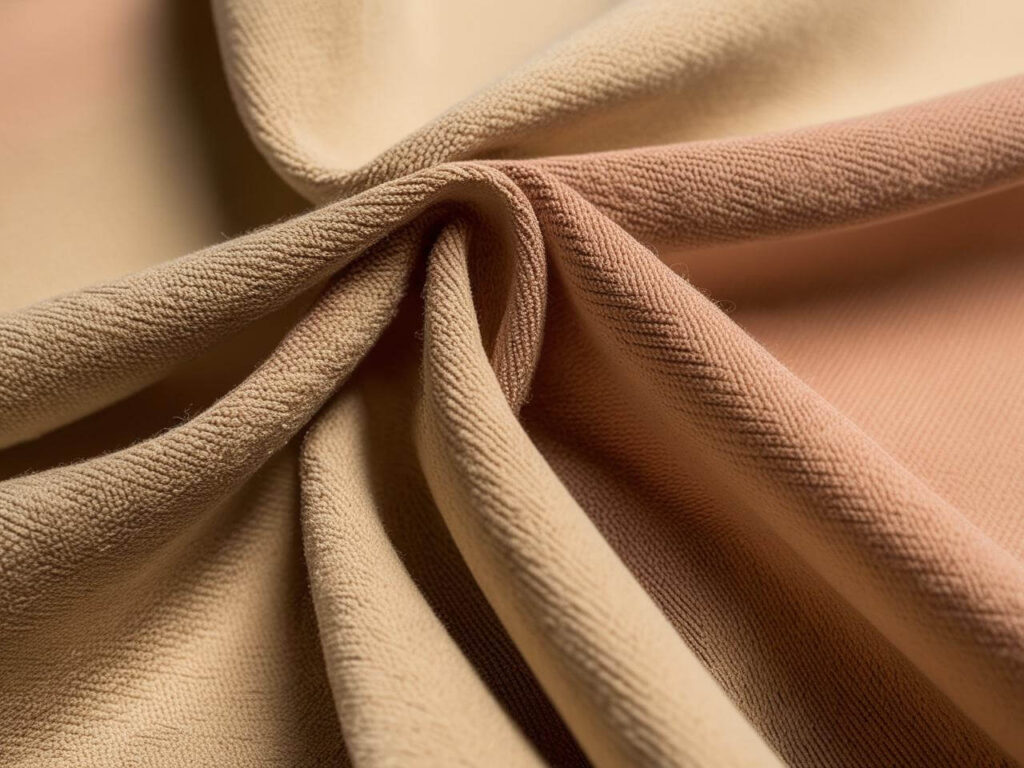Introduction
As the fashion and textile industries move toward sustainability, recycled polyester fabric (rPET) has become a game-changer. Made from recycled plastic bottles and textile waste, rPET reduces pollution, conserves resources, and lowers carbon emissions.
But how does recycled polyester compare to virgin polyester, and why is it gaining popularity in sportswear, activewear, and eco-friendly fashion? In this guide, I’ll explain how recycled polyester is made, its benefits, and where it’s used.
What You’ll Learn in This Guide
✔ What recycled polyester fabric is and how it’s produced
✔ The key differences between recycled and virgin polyester
✔ How recycled polyester contributes to sustainability
✔ Best uses for rPET in fashion, home textiles, and industry
What is Recycled Polyester Fabric?
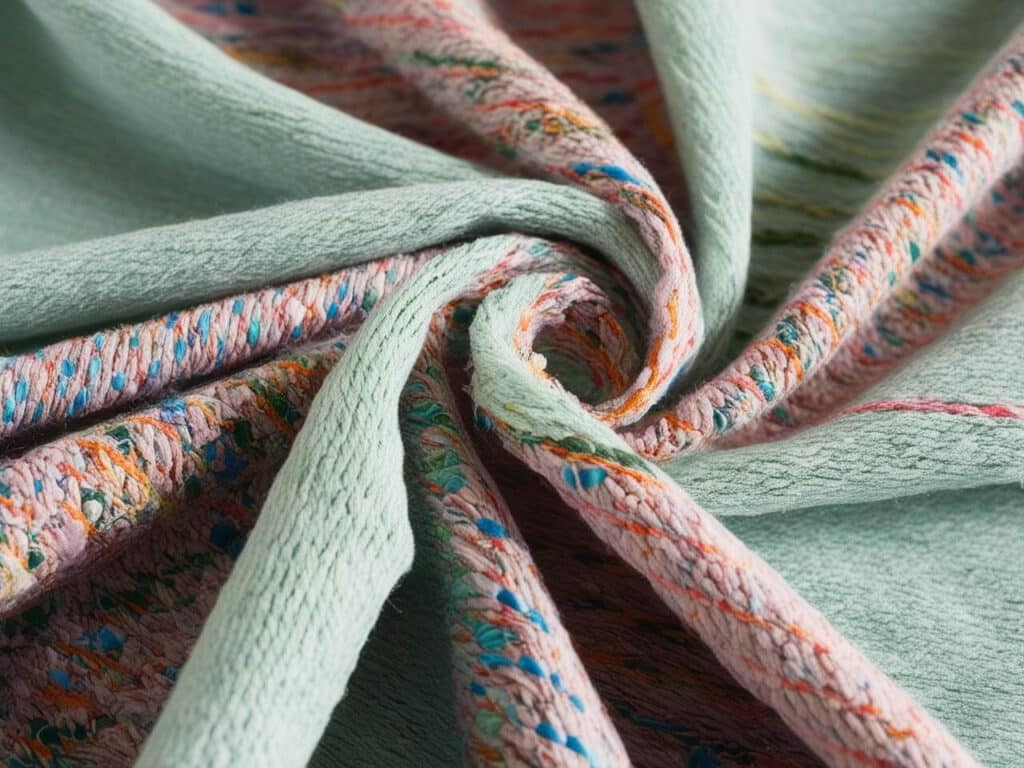
Recycled polyester fabric (rPET) is a sustainable textile made from post-consumer plastic waste, discarded garments, and industrial polyester scraps. This eco-friendly alternative to virgin polyester helps reduce waste, energy consumption, and carbon footprint, making it a key material in sustainable fashion and performance textiles.
📌 Key Features of Recycled Polyester Fabric
- Made from repurposed PET plastic bottles, textile waste, or industrial polyester waste.
- Reduces plastic waste and carbon emissions by reusing existing materials.
- Comparable to virgin polyester in durability and performance.
- Widely used in activewear, sportswear, upholstery, and outdoor gear.
| Feature | Description |
| Sustainability | Reduces plastic pollution, saves energy |
| Common Sources | Recycled PET bottles, discarded polyester textiles |
| Durability | Similar to virgin polyester, long-lasting |
| Water & Energy Savings | Requires less water & energy than virgin polyester |
| Best Uses | Activewear, sportswear, eco-friendly fashion |
✅ Key Advantage: rPET helps brands and consumers move toward a circular economy, minimizing textile waste and reducing environmental harm.
🎥 Recommended YouTube Video
📌 How Recycled Polyester Fabric is Made
🎬 A short video explaining how plastic waste is turned into sustainable recycled polyester textiles.
How is Recycled Polyester Fabric Made?
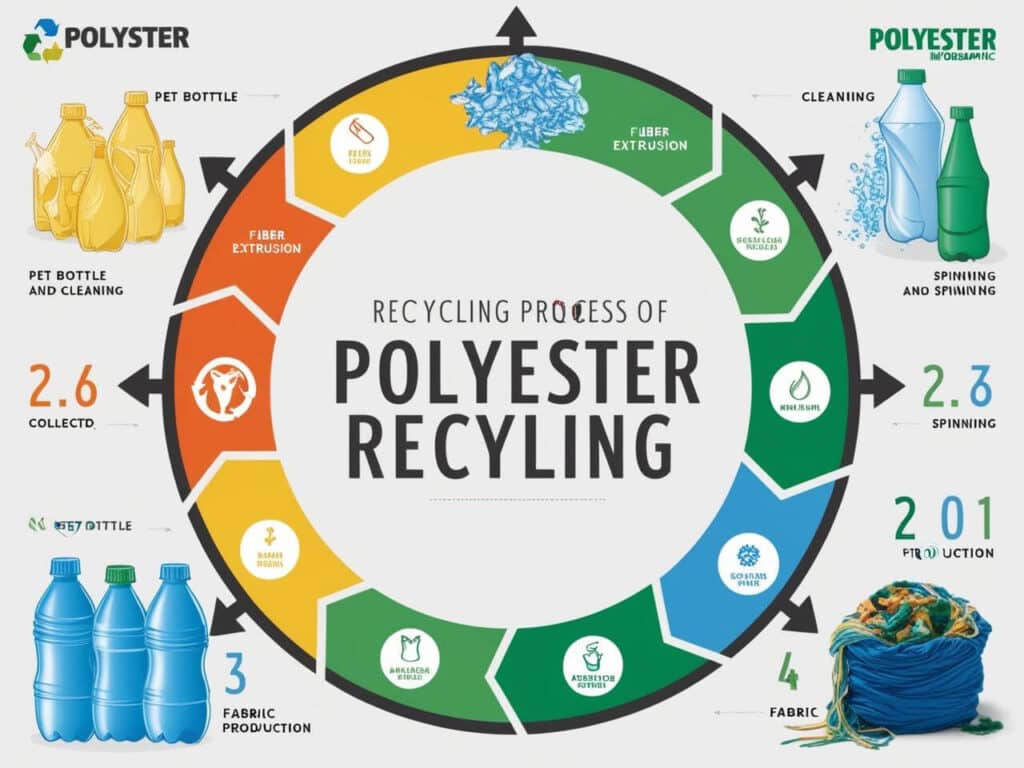
The production of recycled polyester (rPET) involves converting waste plastic into new fibers, significantly reducing environmental impact compared to virgin polyester.
📌 1. The Recycling Process
1️⃣ Collection & Sorting – Used plastic bottles, discarded polyester garments, and industrial waste are gathered.
2️⃣ Cleaning & Shredding – The materials are washed and broken down into flakes to remove contaminants.
3️⃣ Melting & Extrusion – The plastic flakes are melted and transformed into new polyester fibers.
4️⃣ Spinning & Weaving – The fibers are then spun into yarn and woven into fabric.
5️⃣ Finishing Process – The recycled polyester fabric undergoes softening, dyeing, or other finishing treatments before being used.
📌 2. Mechanical vs. Chemical Recycling
| Method | Process | Best For | Pros & Cons |
| Mechanical Recycling | Shreds and re-spins fibers | PET bottles, textile waste | ♻ Lower cost but may reduce fiber strength |
| Chemical Recycling | Breaks down polymers and reprocesses them | High-quality rPET | ♻ Produces stronger fibers, but requires more energy |
✅ Key Insight: Chemical recycling creates higher-quality fibers, but mechanical recycling is more widely used due to lower costs.
🎥 Recommended YouTube Video
📌 How Recycled Polyester is Made – A Behind-the-Scenes Look
🎬 A step-by-step look at how plastic waste is turned into sustainable polyester fabric.
Benefits of Recycled Polyester Fabric
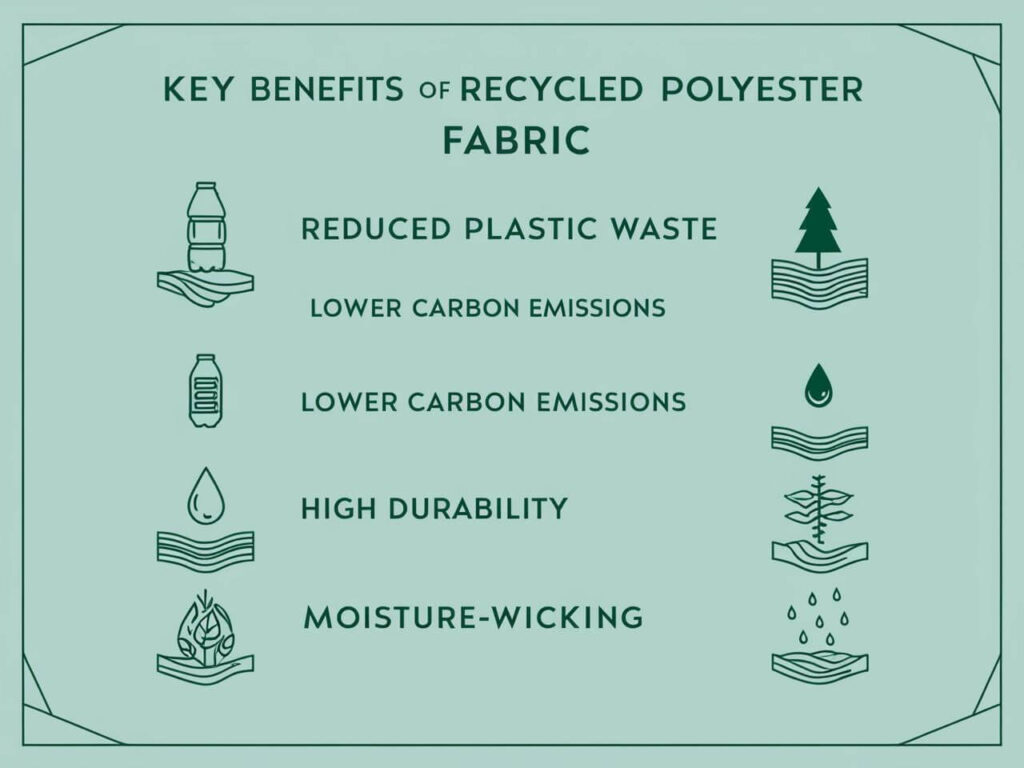
Recycled polyester (rPET) offers environmental, economic, and performance advantages, making it a sustainable alternative to virgin polyester.
📌 1. Environmental Benefits
✅ Reduces Plastic Waste – Diverts millions of PET bottles from landfills and oceans.
✅ Lowers Carbon Emissions – Producing rPET generates up to 79% fewer CO₂ emissions than virgin polyester.
✅ Conserves Water & Energy – Uses 59% less energy and reduces water consumption compared to virgin polyester.
✅ Promotes Circular Economy – Encourages textile-to-textile recycling, reducing the need for new raw materials.
📌 2. Performance & Durability
✅ Comparable Strength to Virgin Polyester – rPET retains high durability, wrinkle resistance, and quick-drying properties.
✅ Lightweight & Moisture-Wicking – Ideal for sportswear, activewear, and outdoor gear.
✅ Resistant to Shrinking & Fading – Performs well after multiple washes, maintaining color vibrancy and shape.
📌 3. Versatility in Fashion & Home Textiles
✅ Used in various industries – Found in fashion, upholstery, and industrial textiles.
✅ Works well in blends – Can be mixed with cotton, spandex, or other sustainable fibers for added softness and stretch.
✅ Available in multiple finishes – Can be brushed, printed, or textured to resemble wool, silk, or cotton.
🎥 Recommended YouTube Video
📌 The Benefits of Recycled Polyester Fabric
🎬 A video explaining why brands and consumers are choosing recycled polyester for sustainability and durability.
Uses & Applications of Recycled Polyester Fabric
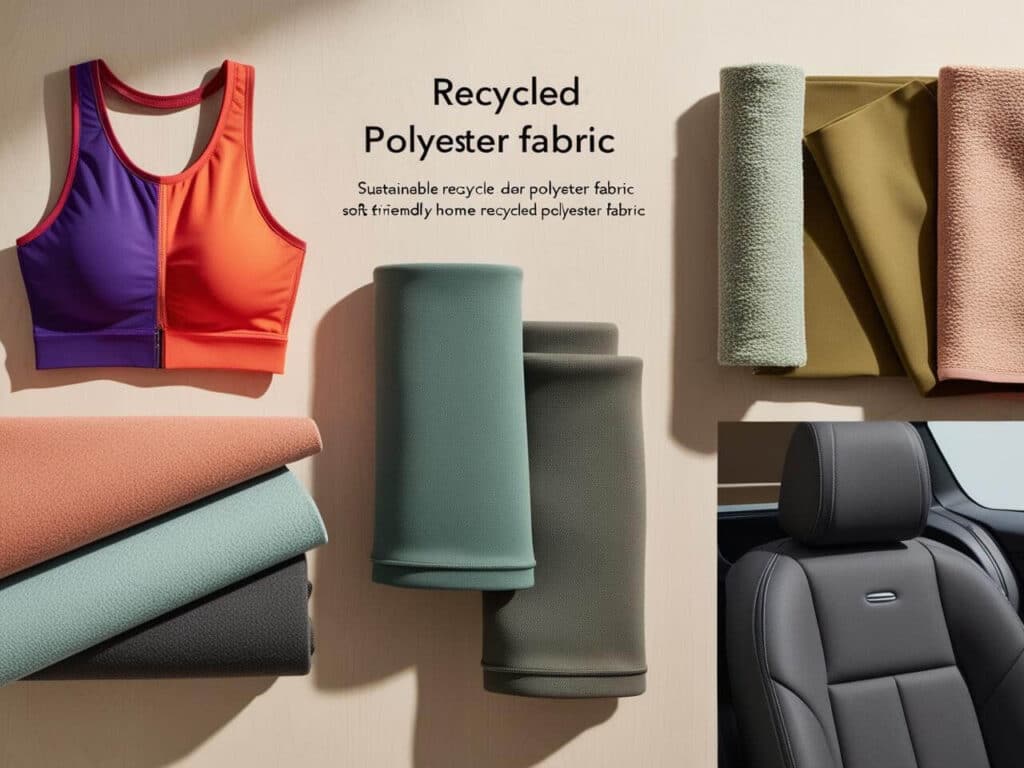
Recycled polyester (rPET) is a versatile and widely used fabric in industries ranging from fashion and activewear to home textiles and industrial applications.
📌 1. Fashion & Apparel
As sustainable fashion gains popularity, rPET is becoming a preferred material for eco-friendly clothing.
| Garment Type | Why Recycled Polyester is Used |
| Activewear & Sportswear | Moisture-wicking, lightweight, and durable |
| T-Shirts & Hoodies | Soft, breathable, and eco-friendly |
| Swimwear & Outdoor Gear | Water-resistant, quick-drying, and strong |
| Luxury & Sustainable Fashion | Eco-conscious brands use rPET for sustainable collections |
✅ Best for: Eco-conscious brands and consumers looking for sustainable alternatives.
📌 2. Home Textiles & Upholstery
Recycled polyester is a durable and practical choice for home applications.
| Application | Why It’s Ideal |
| Bed Sheets & Blankets | Soft, insulating, and long-lasting |
| Curtains & Cushion Covers | Wrinkle-resistant and easy to clean |
| Carpets & Upholstery | Durable, stain-resistant, and sustainable |
✅ Key Insight: Many furniture and textile brands are adopting rPET for sustainable home decor solutions.
📌 3. Industrial & Technical Uses
rPET is also found in technical applications and industrial textiles.
- Car Interiors & Seat Covers – Many automobile brands now use rPET for upholstery and interior lining.
- Recycled Packaging & Bags – Used in shopping bags, tote bags, and eco-friendly packaging.
- Outdoor & Camping Gear – Water-resistant, durable, and lightweight for hiking and travel.
✅ Sustainability Impact: rPET reduces reliance on virgin plastics in multiple industries, making manufacturing more sustainable.
🎥 Recommended YouTube Video
📌 How Recycled Polyester is Used in Fashion & Home Textiles
🎬 A video explaining the various applications of recycled polyester in apparel, upholstery, and industrial products.
Recycled Polyester vs Virgin Polyester
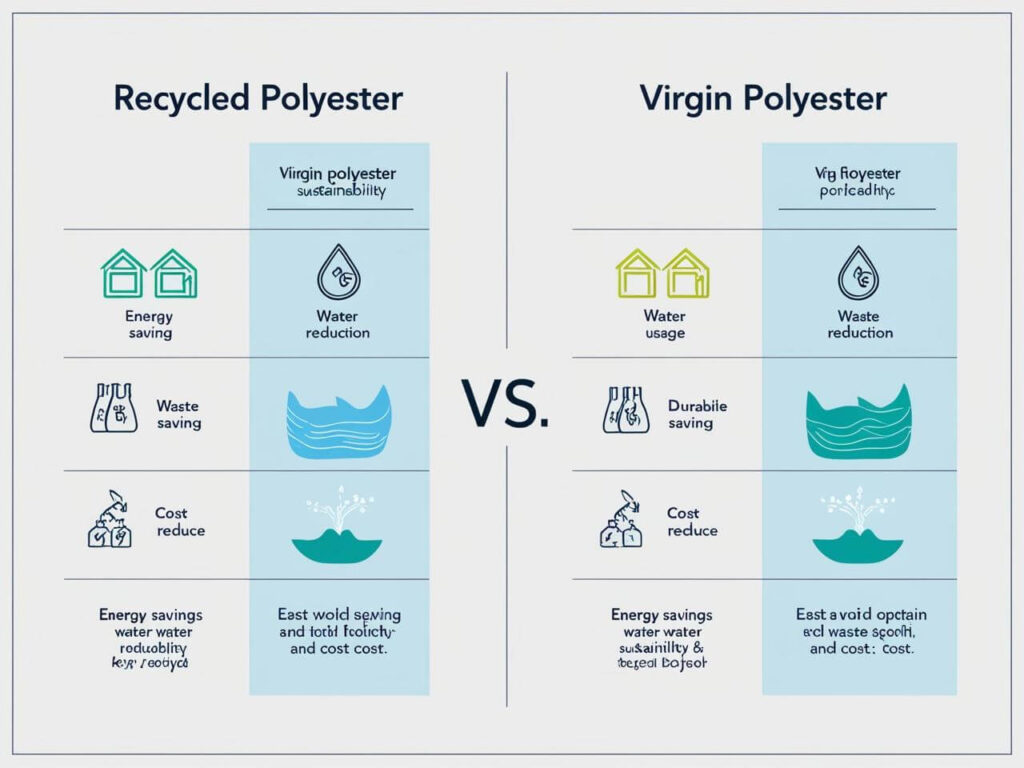
To help consumers and businesses make informed choices, let’s compare recycled polyester (rPET) with virgin polyester in terms of sustainability, durability, and cost.
📌 1. Sustainability Comparison
| Factor | Recycled Polyester (rPET) | Virgin Polyester |
| Environmental Impact | Low – Uses existing plastic waste | High – Relies on fossil fuels (petroleum) |
| Water & Energy Consumption | Uses 59% less energy | High energy & water usage |
| Waste Reduction | Prevents plastic pollution | Contributes to textile & plastic waste |
✅ Key Takeaway: Recycled polyester significantly reduces waste and energy consumption, making it a more sustainable option.
📌 2. Durability & Performance
| Factor | Recycled Polyester (rPET) | Virgin Polyester |
| Strength & Longevity | Comparable to virgin polyester, slightly weaker in some cases | Strong and durable |
| Softness & Comfort | Can be slightly rougher depending on processing | Often smoother due to controlled fiber production |
| Stretch & Flexibility | Good elasticity, especially in blended fabrics | Naturally stretchable and retains shape |
✅ Key Takeaway: Recycled polyester performs similarly to virgin polyester, though some variations may be slightly less soft.
📌 3. Cost & Market Availability
| Factor | Recycled Polyester (rPET) | Virgin Polyester |
| Production Cost | Can be higher due to recycling process | Generally cheaper to produce |
| Market Availability | Growing demand, but still less widely available than virgin polyester | More commonly used across industries |
✅ Key Takeaway: While recycled polyester costs more to produce, the growing demand for sustainable textiles is making it more accessible and affordable.
🎥 Recommended YouTube Video
📌 Recycled Polyester vs. Virgin Polyester – Which is More Sustainable?
🎬 A video comparison of recycled polyester and virgin polyester in terms of environmental impact, durability, and cost.
Pros & Cons of Recycled Polyester Fabric
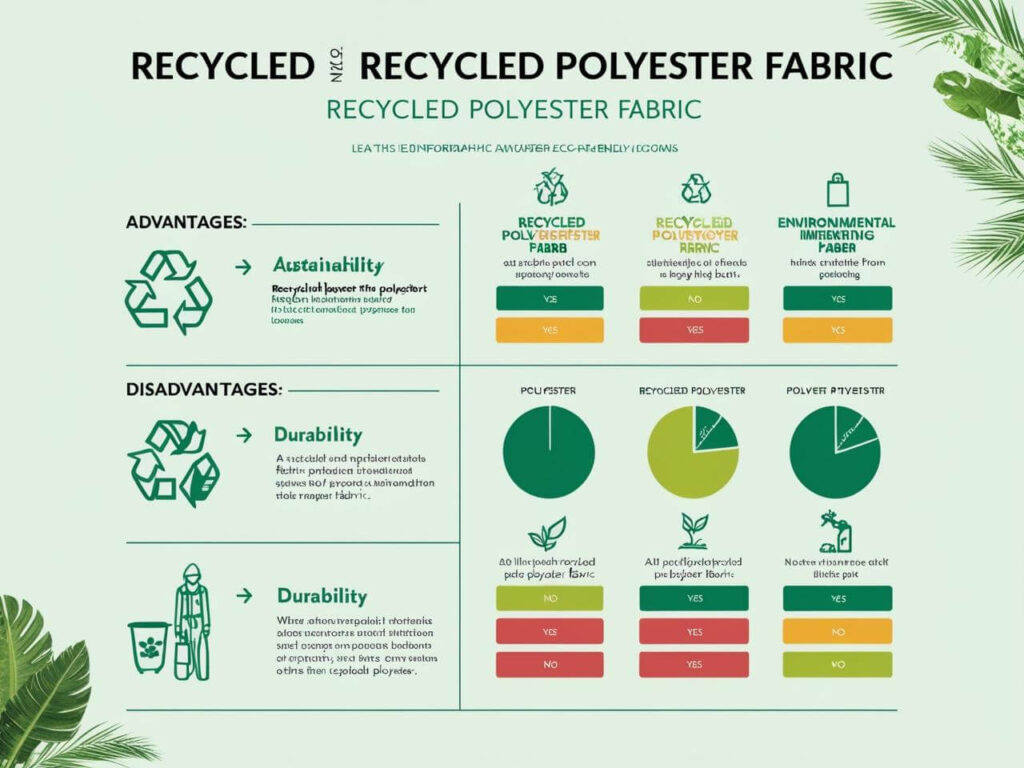
While recycled polyester (rPET) is a major step toward sustainability, it has both advantages and challenges. Here’s a breakdown of its pros and cons:
📌 1. Advantages of Recycled Polyester Fabric
✅ Eco-Friendly & Sustainable – Helps reduce plastic pollution, carbon emissions, and water consumption.
✅ Comparable to Virgin Polyester in Durability – rPET retains high strength, wrinkle resistance, and quick-drying properties.
✅ Energy & Resource Savings – Producing rPET requires 59% less energy and reduces CO₂ emissions by up to 79%.
✅ Versatile for Fashion, Home Textiles & Industry – Used in sportswear, upholstery, automotive interiors, and outdoor gear.
✅ Promotes Circular Economy – Supports recycling efforts and reduces dependence on fossil fuels.
📌 2. Disadvantages of Recycled Polyester Fabric
❌ Higher Production Costs – Recycling involves sorting, cleaning, and processing, making rPET slightly more expensive.
❌ Quality Limitations in Some Cases – Some mechanically recycled fibers may be weaker than virgin polyester.
❌ Microplastic Shedding – Like virgin polyester, rPET can release microplastics into water during washing.
❌ Limited Color Options – Some recycled polyester fabrics absorb dye differently, affecting color consistency.
🎥 Recommended YouTube Video
📌 The Pros & Cons of Recycled Polyester Fabric – Is It Worth It?
🎬 A detailed explanation of the benefits and drawbacks of recycled polyester in fashion and industry.
FAQs: Everything You Need to Know About Recycled Polyester Fabric
To help clarify common concerns about recycled polyester (rPET), here are concise and informative answers to frequently asked questions.
❓ Is recycled polyester as durable as virgin polyester?
✔ Yes, in most cases. High-quality rPET is nearly identical to virgin polyester in terms of strength, wrinkle resistance, and quick-drying properties. However, mechanically recycled polyester may have slightly shorter fibers, affecting long-term durability.
❓ What are the environmental benefits of recycled polyester?
✔ rPET significantly reduces plastic waste, saves 59% more energy, and cuts CO₂ emissions by up to 79% compared to virgin polyester.
❓ Does recycled polyester shrink?
✔ Not significantly. Like virgin polyester, rPET is resistant to shrinking but may deform slightly under high heat. It’s best to wash it in cold water and air dry.
❓ Can recycled polyester be recycled again?
✔ Yes, but with limitations. Some mechanical recycling processes degrade the fiber strength, but chemical recycling allows for multiple reuse cycles.
❓ What is recycled polyester best used for?
✔ Most commonly used for:
- Activewear & sportswear (moisture-wicking, durable, and lightweight)
- Swimwear & outdoor gear (water-resistant, quick-drying)
- Sustainable fashion (eco-friendly T-shirts, dresses, and jackets)
- Home textiles (curtains, cushions, and bed linens)
🎥 Recommended YouTube Video
📌 Recycled Polyester Fabric Explained – Common FAQs
🎬 A video addressing common questions about recycled polyester, including durability, cost, and best applications.
Final Thoughts: Why Recycled Polyester Fabric is a Sustainable Choice
Recycled polyester (rPET) is one of the most impactful innovations in sustainable textiles, offering an eco-friendly alternative to virgin polyester while maintaining durability, versatility, and cost-effectiveness. Whether you’re a fashion consumer, business owner, or sustainability advocate, rPET provides a practical way to reduce plastic waste and carbon emissions.
✔ Key Takeaways
✅ Reduces plastic waste – Diverts millions of plastic bottles from landfills and oceans.
✅ Conserves resources – Uses 59% less energy and generates up to 79% fewer CO₂ emissions than virgin polyester.
✅ Performs similarly to virgin polyester – Offers high durability, wrinkle resistance, and quick-drying properties.
✅ Versatile for fashion, home textiles & industrial applications – Used in sportswear, upholstery, outdoor gear, and car interiors.
✅ A growing trend in sustainability – More brands are switching to rPET to meet environmental goals and reduce fossil fuel dependency.
If you’re considering recycled polyester fabric for your next project or purchase, it’s a high-performing, sustainable alternative that supports a greener, more responsible textile industry.
